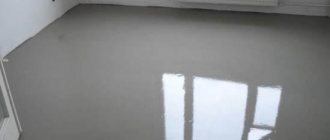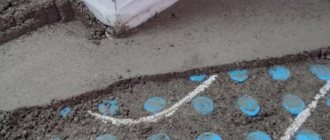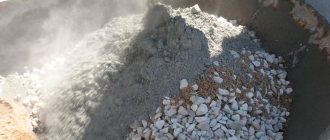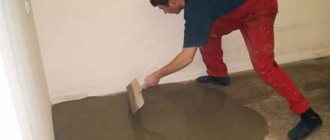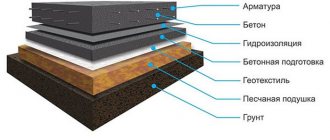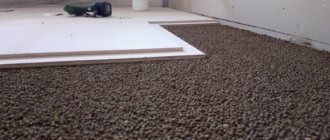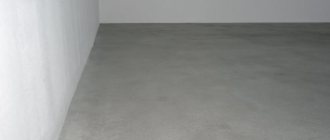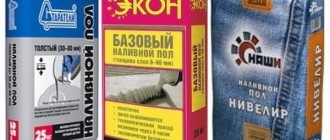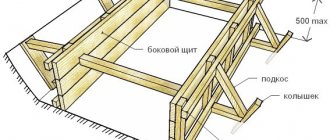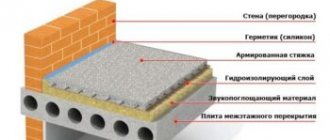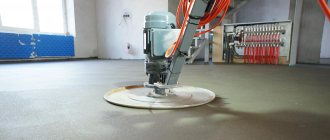Polystyrene concrete screed
We are all familiar with concrete screed, which over decades of use has already become synonymous with a smooth and durable floor. However, despite all the advantages of such a coating, it also has quite significant disadvantages, among which one can highlight its coldness.
Technologies do not stand still, and not so long ago floor screeds with polystyrene concrete appeared in the construction space, which we will talk about in today’s article. This solution is not only warmer than its predecessor, but also has other advantages, as well as disadvantages.
What is polystyrene concrete
What is a coating with such a mysterious name? Everything is extremely simple, in fact, the name reveals the whole essence of this material.
The smaller the foam fraction, the better the polystyrene concrete floor screed
- It consists of 85% granules of primary or secondary foam, replacing fillers in the form of sand and crushed stone.
Cement grade M500
- Portland cement grade 400 or 500 is used as a binder.
Sand quarrying
- Sometimes washed sand is additionally added to the mixture to increase strength, but it is worth remembering that the energy efficiency of such concrete will decrease proportionally.
Super plasticizer will wet the foam
- An obligatory component is also a plasticizer, which, first of all, is needed for good wettability of the foam - to prevent it from floating to the surface of the water, and to improve the mobility of the mixture.
Advice! Liquid detergents can be used as plasticizing mixtures when preparing such concrete at home.
Polystyrene concrete floor screed: ratio of components by density
The table above shows the ratio of the main components of the concrete solution. As you can see, the recipe is indicated three times according to the final density, which is selected according to the place where the screed will be used. In particular, a polystyrene concrete screed may have a minimum density of D200 (top line in the table).
If we translate the recipe into classical parts, we get the following:
- Water - 0.5 parts;
- Cement - 1 part;
- Polystyrene foam - 4 parts;
- Well, and a plasticizer, which is added according to the manufacturer’s instructions.
Interesting to know! If you plan to use the screed in public places, then it is better to increase the concrete density to D 300.
In general, expanded polystyrene concrete can also be used in more serious structures, for example, for pouring the foundations of low-rise buildings or making wall blocks, which in some characteristics are much superior to the foam and gas blocks so popular today.
Advantages of polystyrene screed
Creation of a polystyrene concrete screed on a permanent foundation, which, by the way, is a prerequisite
So, let's voice all the pros and cons of such a solution in order to understand when it is worth using it and when not.
- Due to its low thermal conductivity, this floor does not require additional insulation.
- The mass of such a mixture (with the same volume) will be much less than that of classic concrete. This means less load on the foundation and floors of the building.
- Concrete based on polystyrene practically does not shrink, which means it is quite resistant to cracks and deformations.
- Polystyrene foam, especially recycled plastic, is an inexpensive raw material that will help you save on construction. It is easier to deliver it to the object, and lifting it to a height will not pose any problems at all.
Open flame testing of polystyrene concrete
- Despite the fact that polystyrene foam burns and melts well when it gets into the concrete mixture, it becomes invulnerable to fire due to the cement layer. You can see this with your own eyes by looking at the test result in the photo below.
Cutting down polystyrene concrete blocks after fire testing
As you can see, the polystyrene concrete granules remained absolutely undamaged, which is good news.
Flaws
There are few of them, but for some they may seem significant.
- Firstly, the material has a fairly low strength and is not able to withstand serious mechanical loads, which is why it is necessary to construct a rough foundation made of ordinary concrete under such a screed.
- Secondly, the surface is easily abraded, and a finishing coating is required for both floors and walls. This drawback can be called conditional, since any screeds are finished off on top.
The above means that such coatings are suitable only for installation in residential and public premises, excluding industrial production.
Application in areas with high traffic requires topping - pouring a strengthening mixture onto the concrete surface. The basis of such mixtures is also cement, which is supplemented with various fillers: quartz, corundum fillers, metal particles and others. The composition also includes various chemical additives that improve the workability of the material.
The simplest solution for topping is a cement-based self-leveling floor. The surface will be not only very durable, but also very even and smooth.
Polystyrene concrete screed is an excellent base for ceramic tiles
Advice! There is no need for topping if tiles are laid over the screed, because tile adhesive will provide additional protection.
To strengthen the surface of polystyrene concrete, it is recommended to perform ironing - a procedure for applying special compounds, performed after the solution has partially set. Typically, dry cement is used for this, which is sprinkled on top and rubbed well with a trowel until a dense glossy film is formed on the surface.
Production of polystyrene concrete
Now let's talk a little about making such mixtures with your own hands and pouring them.
Prepackaged bags of polystyrene granules
- So, polystyrene is supplied to construction markets in bags of 420 and 170 liters, which is very convenient for transportation.
Wood saponified resin
- SDO (saponified wood resin) is also purchased there, which serves as an air-entraining additive. If it is not available, then you can prepare concrete this way, but the mixture will turn out to be heavier and denser, which will affect its thermal conductivity. However, it will still be much warmer than regular concrete. With the addition of SDO, you will get a screed made of expanded polystyrene concrete.
- The mixture can be prepared in a concrete mixer or manually. The first method is preferable, since the components mix much better.
Mixing polystyrene concrete mortar
The work is performed in the following sequence.
- A measured amount of water is poured into the concrete mixer drum;
- Next, the plasticizer is poured in, after which SDO is poured in if desired;
- The concrete mixer is started and polystyrene foam is placed into it in portions;
- As a result, you will end up with a mass of sticky lumps, into which cement is then added.
- The mixture is stirred, in general, for about 10 minutes, until a homogeneous mass is obtained.
The setting time of such a solution will be short, so after mixing you need to immediately install it.
Screed device
Beacon screed
Polystyrene concrete floor screed is poured without problems, as it is made using the same technology as conventional concrete. And due to the fact that the mixture does not have much mass, it will be much easier to stretch. Here are the step-by-step instructions.
Lack of dust is the key to good adhesion
- First, the floor surface is cleaned of dust with a brush or vacuum cleaner.
Installed beacons help level the surface
- Then beacons are installed on the floor. Do this in any way convenient for you, but we praise the method using rolled steel rectangular pipes, under which you just need to place something so that the lighthouse takes a horizontal position. The wide furrow left behind can easily be sealed with the same polystyrene concrete mixture.
- Next, the surface is primed using cement laitance or water. You shouldn’t go through it all at once, since we have to work “wet on wet” (the primer should not dry out) to ensure sufficient adhesion of the surfaces.
Supplying the mixture to the laying site with a concrete pump
- The space between the beacons is filled with concrete mixture so that it protrudes slightly beyond their boundaries.
- Next, the polystyrene concrete is leveled using a rule to remove excess. As we have already written, such a mixture will be easier to stretch. If the composition of the solution does not contain a plasticizer, then before drawing it will additionally have to be slapped on top to compact it - completely unnecessary manipulations, so do not skimp and complete the composition completely.
- Do not tilt the rule too much so that it does not bend and select too much.
- Removal of beacons and filling of traces from them is carried out 24 hours after filling. Under no circumstances do this with ordinary cement-sand mortar - the composition of the mixture should be the same.
- No matter how you mix polystyrene concrete, it is impossible to make it homogeneous. For this reason, it is very difficult to stretch this coating to zero, especially if recycled foam was used, the particle fraction of which can reach 10 millimeters, so an underlying layer up to 3 centimeters thick is made from polystyrene concrete.
- The already stretched screed must be covered with plastic film, and this must be done simultaneously with the passage of the floor area.
Strength gains occur in the first 4-5 days, after which the film can be finally removed and the floor left to dry for up to two weeks. Final leveling or tiling can only be carried out after the specified time has elapsed.
Store option
Ready-made light screed
If you don’t want to look for individual components in stores and follow the recipe, then, as an alternative, you can purchase a ready-made Knauf Ubo mixture from a world-famous manufacturer, or similar solutions. All you need to do when working with this material is to stir it in a container with clean water. This solution has high thermal insulation properties, but it cannot withstand more than 10 Pa in compression, which does not meet the requirements of SNiP.
Therefore, such mixtures are used only as thermal insulation and a leveling layer in prefabricated screeds. Plus, do not forget that the price of such a coating will be much higher than if you start preparing the concrete yourself.
The thickness of the coating layer also does not exceed 3 centimeters. On top of it you can install a cement-sand screed reinforced with fiberglass or steel mesh. A DIY polystyrene concrete floor is a rational solution in the absence of additional insulating layers. You can learn more about filling it from the video in this article. Best wishes!
As a rule, we use Polytherm filler for polystyrene concrete screeds.
Polyterm is a foamed polystyrene foam filler in granules
with a diameter of 3 to 5 mm. It has a distinctive color - blue. This was done so that it cannot be confused with other white polystyrene foam granules.
Polytherm is produced using modern technology in special equipment in which it goes through two phases of preparation. With each production phase, the granules increase in size without losing thermal conductivity.
Expanded polystyrene filler cannot be replaced when installing floors (warm floor screed), where only three components are needed. Water, cement and polytherm. The result is warm floors – this saves usable space and provides thermal insulation.
Polytherm goes well with cement mortar. During the production process, the granules are processed in such a way that they do not float and are easily mixed in the solution. Uniform mixing gives the greatest effect of strength and thermal conductivity. The density of the final product is achieved by increasing the proportions of cement and water. Polytherm consumption remains unchanged.

